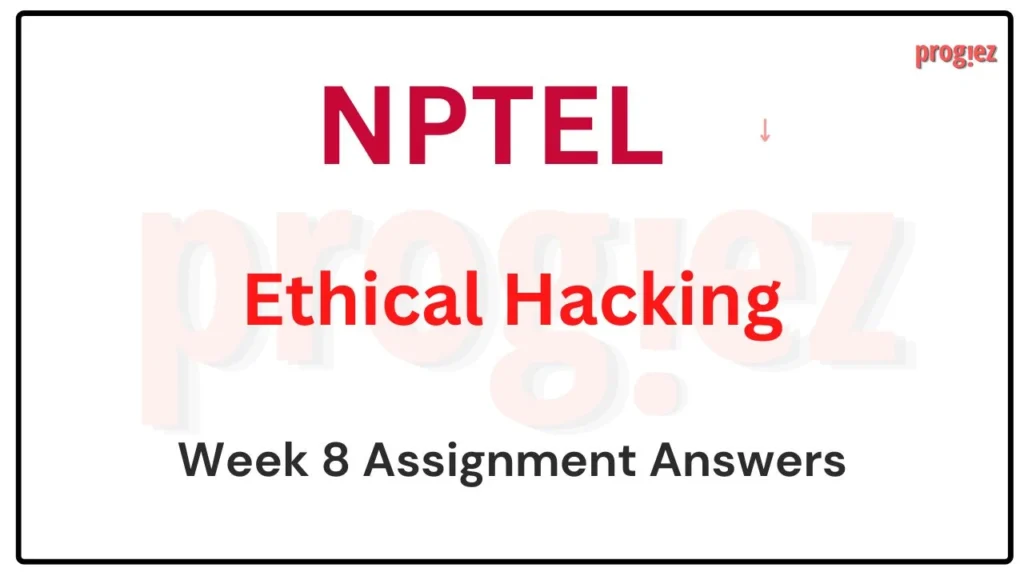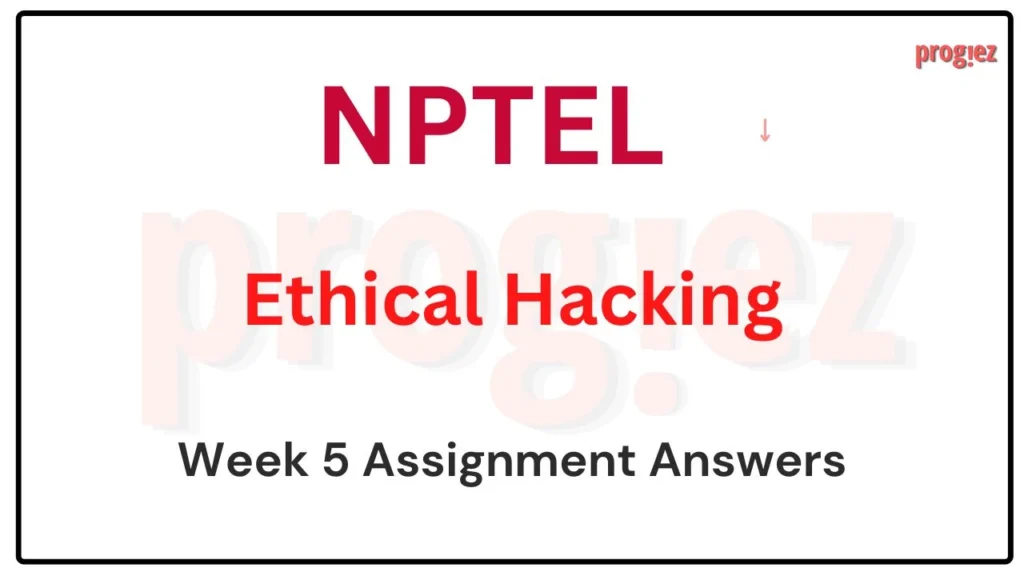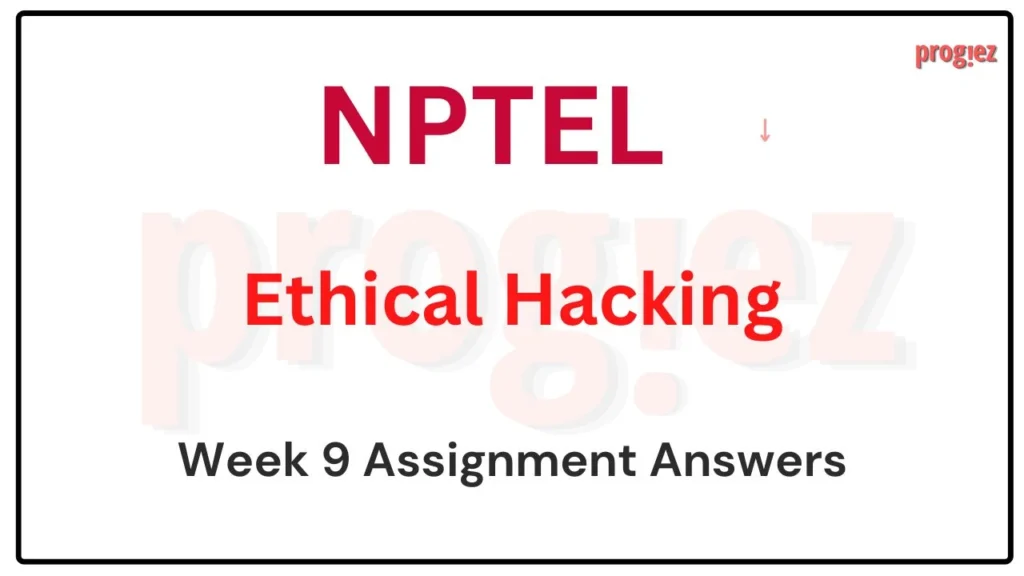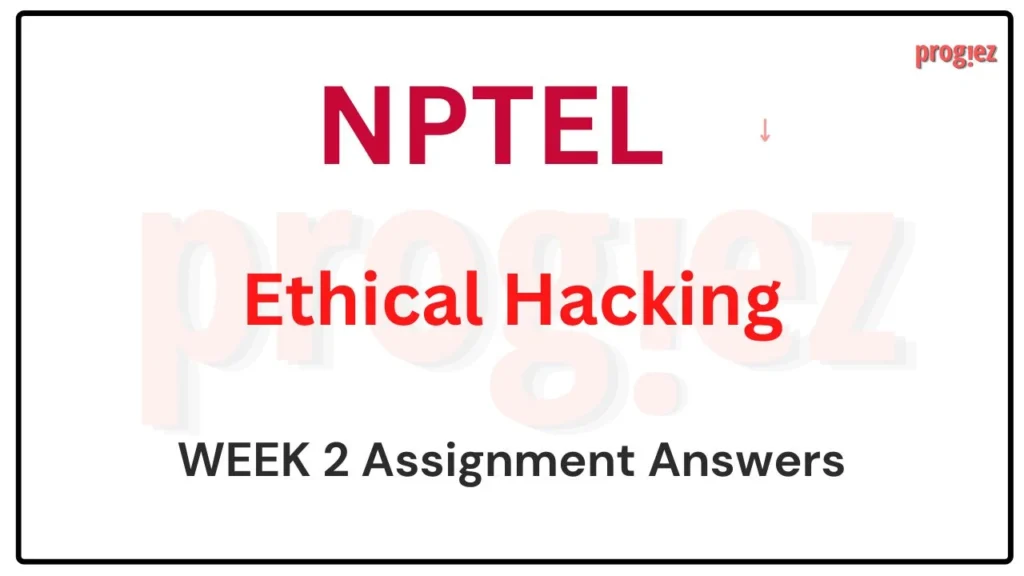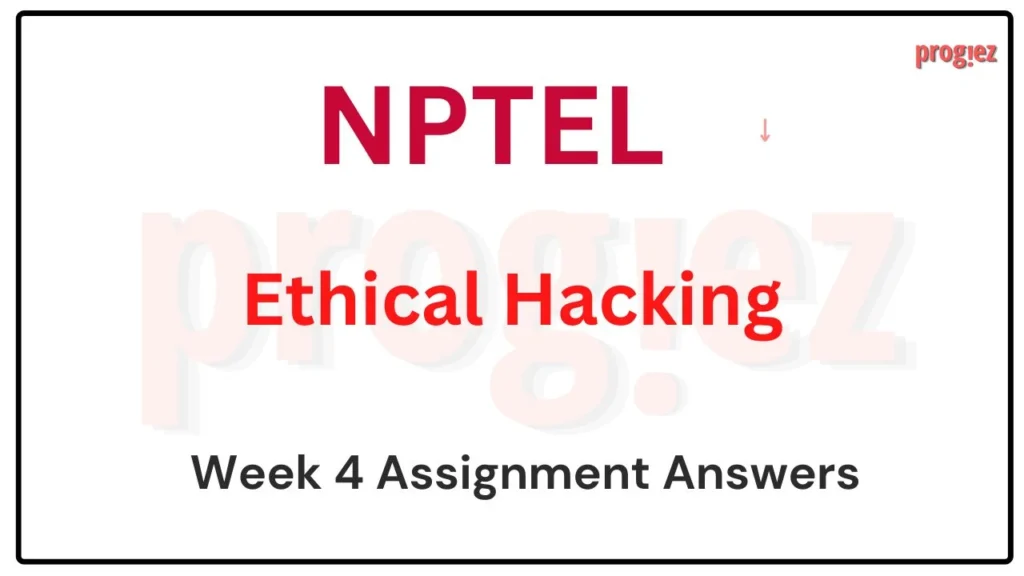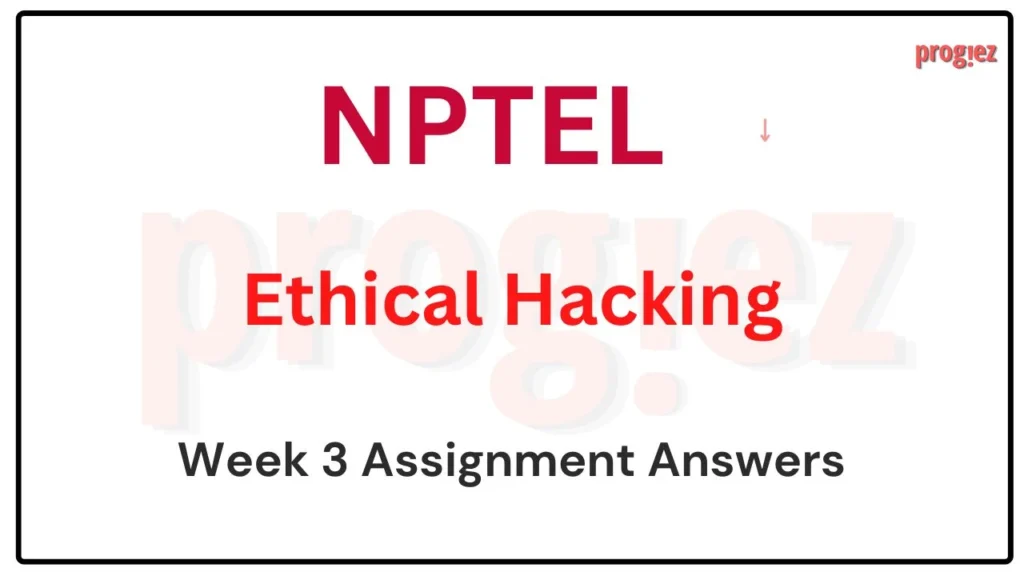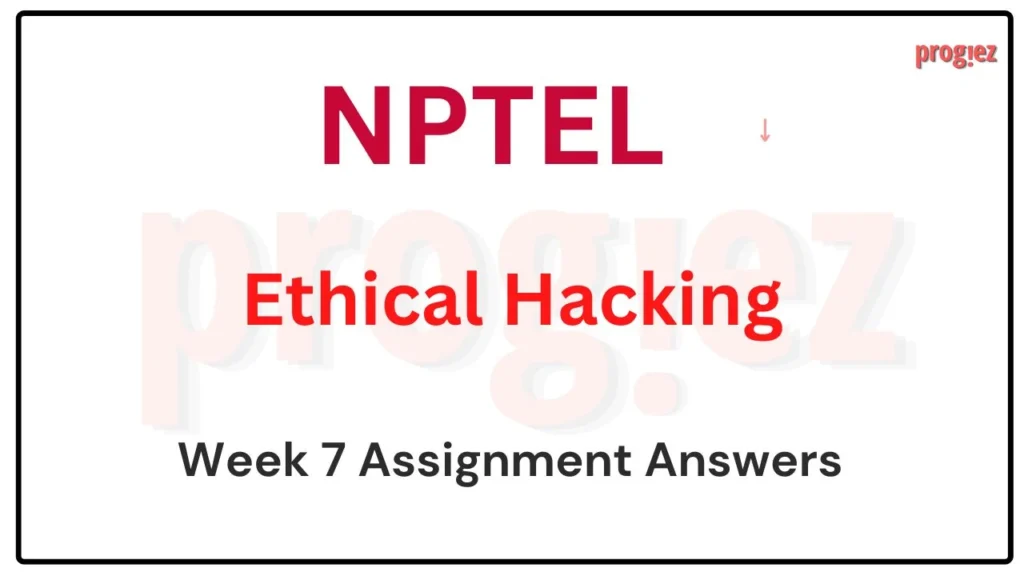Ethical Hacking Nptel Week 6 Assignment Answers
Are you looking for Ethical Hacking Nptel Week 6 Assignment Answers? You’ve come to the right place! Access the latest and most accurate solutions for your Week 6 assignment in the Ethical Hacking course.
Course Link: Click Here
Table of Contents
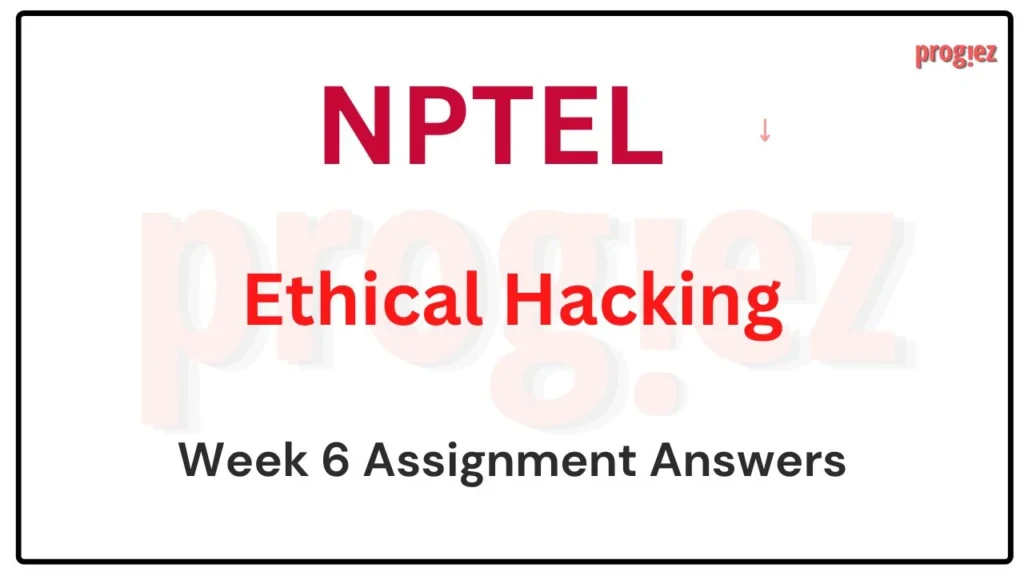
Ethical Hacking Nptel Week 6 Assignment Answers (July-Dec 2024)
Q1 .Which of the following statements is true for Masquerade attack?
a. In this attack, some portion of message is altered on its way.
b. In this attack, an attacker prevents access of resource to its legitimate users.
c. In this attack, the attacker pretends as a legitimate entity.
d. In this attack, the attacker analyzes the network traffic.
Answer: c. In this attack, the attacker pretends as a legitimate entity.
Q2Which of the following is an example of passive security attack?
a. Traffic analysis
b. Replay
c. Modification
d. Denial of Service
e. None of these
Answer: a. Traffic analysis
For answers or latest updates join our telegram channel: Click here to join
Q3.Which of the following statement(s) is/are true?
a. In symmetric key cryptography, separate keys are used by sender and receiver.
b. In symmetric key cryptography, a single key is used by sender and receiver.
c. Inasymmetric key cryptography, separate keys are used by sender and receiver.
d. In asymmetric key cryptography, a single key is used by sender and receiver.
Answer: b. In symmetric key cryptography, a single key is used by sender and receiver.
c. Inasymmetric key cryptography, separate keys are used by sender and receiver.
Q4.Consider the following statement:
(i) In symmetric key cryptography, the security depends on secrecy of the key.
(ii) In symmetric key cryptography, the security depends on the secrecy of the
encryption/decryption algorithm.
a. Only (i) is true
b. Only (ii) is true
c. Both (i) and (ii) are true.
d. Both (i) and (ii) are false.
Answer: a. Only (i) is true
For answers or latest updates join our telegram channel: Click here to join
Q5.25 parties want to exchange messages securely using a private key encryption algorithm. The
number of distinct key values required will be .
Answer: 300
Q6.Consider a cipher text “GVCTXSKVETLC” encrypted using a substitution cipher approach, where |
each letter is replaced by the k-th next letter.
Assumption:
(i) The alphabets are wrapped around, i.e. Z is followed by A.
(ii) Each alphabet (A to Z) is assigned a number (1 to 26).
i. PB
(iii) The value of secret key k is 4.
What will be the plain text?
a. HAPPYNEWYEAR
b. CRYPTOGRAPHY
c. SECURENETWOR
d. CRYPTOGRAPHIC
e. None of these.
Answer: b. CRYPTOGRAPHY
For answers or latest updates join our telegram channel: Click here to join
Q7.Consider a mono-alphabetic cipher with the following key value:
(ABWXEFSTIJOPMNKLQRGHUVCDYZ)
What will be the encrypted form of the message “ALPHABETIC” ?
a. APLTABEHIW
b. ALPHABETIC
c. WXLTABEHIC
d. None of these.
Answer: d. None of these.
Q8.If a sender A wants to carry out encryption on a message and send it to receiver B using public-
key cryptography. Which of the following key will be used for decryption at receiver end B?
a. A’s public key
b. A’sprivate key
B’s public key
d. B’s private key
Answer: d. B’s private key
For answers or latest updates join our telegram channel: Click here to join
Q9.The effective key length use in AES encryption algorithm can be:
a. 64 bit
b. 128 bit
c. 192 bit
d. 256 bit
e. 513 bit.
Answer: b. 128 bit
c. 192 bit
d. 256 bit
Q10.50 parties want to exchange messages securely using some public key encryption technique like
RSA. The number of distinct key values required will be .
Answer: 100
For answers or latest updates join our telegram channel: Click here to join
More Weeks of Ethical Hacking: Click here
For answers to additional Nptel courses, please refer to this link: NPTEL Assignment
Ethical Hacking Nptel Week 6 Assignment Answers (Jan-Apr 2024)
Course Name: Ethical Hacking
Course Link: Click Here
These are NPTEL Ethical Hacking Assignment 6 Answers
Q1. Which of the following statement is true for Masquerade attack?
a. In this attack, an attacker passively captures a transaction and its reply.
b. In this attack, some portion of message is altered on its way.
c. In this attack, an attacker prevents access of resource to its legitimate users.
d. In this attack, the attacker pretends as a legitimate entity.
e. In this attack, the attacker analyzes the network traffic.
Answer: d. In this attack, the attacker pretends as a legitimate entity.
Q2. Which of the following statement(s) is/are true?
a. In private key encryption, separate keys are used by sender and receiver.
b. In private key encryption, a single key is used by sender and receiver.
c. In public key encryption, separate keys are used by sender and receiver.
d. In public key encryption, a single key is used by sender and receiver.
Answer: b, c
These are NPTEL Ethical Hacking Assignment 6 Answers
Q3. Consider the following statement:
(i) In symmetric key cryptography, the security depends on secrecy of the key.
(ii) In symmetric key cryptography, the security depends on encryption/decryption algorithm.
a. Only (i) is true
b. Only (ii) is true
c. Both (i) and (ii) are true.
d. Both (i) and (ii) are false.
Answer: a. Only (i) is true
Q4. 25 parties want to exchange messages securely. The number of distinct key required by a symmetric key encryption algorithm and public key encryption technique like RSA will be _____ and ____ respectively.
a. 25 and 50
b. 50 and 50
c. 100 and 50
d. 300 and 25
e. 300 and 50
Answer: e. 300 and 50
These are NPTEL Ethical Hacking Assignment 6 Answers
Q5. How will be the plaintext for the cipher text “LETTY CEIV” encrypted using a substitution cipher
approach, where each letter is replaced by the k-th next letter. (Assumption: (i) the alphabets
are wrapped around, i.e. Z is followed by A, (ii) each alphabets (A to Z) is assigned a number (1
to 26), (iii) the value of secrete key k is 4).
a. HAPPY YEAR
b. HAPPU YAER
c. HAPPY YEAR
d. None of this
Answer: b. HAPPU YAER
Q6. In data encryption standard (DES), longer plain text are processed in _______ bit blocks.
Answer: 64
These are NPTEL Ethical Hacking Assignment 6 Answers
Q7. The effective key lengths used in AES encryption algorithms can be:
a. 64 bit
b. 128 bit
c. 192 bit
d. 256 bit
e. 512bit
Answer: b, c, d
Q8. For decryption using public-key cryptography _______ is used.
a. Receivers public key
b. Receiver’s private key
c. Sender’s public key
d. Sender’s private key
Answer: b. Receiver’s private key
These are NPTEL Ethical Hacking Assignment 6 Answers
Q9. Which of the following statement(s) is/are true.
a. The security of RSA algorithm is dependent on prime factorization problem.
b. RSA algorithm is vulnerable to man-in-the middle attack.
c. Diffie-Hellman approach can be used for encryption/decryption of message.
d. Symmetric encryption approaches are faster than asymmetric encryption.
e. None of these.
Answer: a, d
Q10. Which of the following techniques cannot be used for message authentication?
a. Conventional encryption approach such as private key.
b. MD4
c. SHA-256
d. SHA-0
e. RIPEMD-128
Answer: d. SHA-0
These are NPTEL Ethical Hacking Assignment 6 Answers

